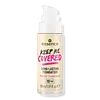What's inside
What's inside
 Key Ingredients
Key Ingredients

 Benefits
Benefits

 Concerns
Concerns

 Ingredients Side-by-side
Ingredients Side-by-side

Water
Skin ConditioningCyclopentasiloxane
EmollientTalc
AbrasiveTrimethylsiloxysilicate
EmollientPEG-10 Dimethicone
Skin ConditioningGlycerin
HumectantCetyl PEG/PPG-10/1 Dimethicone
EmulsifyingAloe Barbadensis Leaf Juice
Skin ConditioningTropolone
Skin ConditioningSodium Hyaluronate
HumectantSodium Chloride
MaskingDisteardimonium Hectorite
StabilisingHydrogen Dimethicone
Sodium Phytate
Propylene Carbonate
SolventAluminum Hydroxide
EmollientPhenoxyethanol
PreservativeSodium Dehydroacetate
PreservativeParfum
MaskingCI 77491
Cosmetic ColorantCI 77492
Cosmetic ColorantCI 77499
Cosmetic ColorantCI 77891
Cosmetic ColorantWater, Cyclopentasiloxane, Talc, Trimethylsiloxysilicate, PEG-10 Dimethicone, Glycerin, Cetyl PEG/PPG-10/1 Dimethicone, Aloe Barbadensis Leaf Juice, Tropolone, Sodium Hyaluronate, Sodium Chloride, Disteardimonium Hectorite, Hydrogen Dimethicone, Sodium Phytate, Propylene Carbonate, Aluminum Hydroxide, Phenoxyethanol, Sodium Dehydroacetate, Parfum, CI 77491, CI 77492, CI 77499, CI 77891
Water
Skin ConditioningIsododecane
EmollientC13-15 Alkane
SolventPolyglyceryl-4 Diisostearate/Polyhydroxystearate/Sebacate
EmulsifyingC12-15 Alkyl Benzoate
AntimicrobialZinc Stearate
Cosmetic ColorantPropanediol
SolventMagnesium Sulfate
Pentylene Glycol
Skin ConditioningTocopherol
AntioxidantEthylene Brassylate
Masking1,2-Hexanediol
Skin ConditioningDisteardimonium Hectorite
StabilisingCaprylhydroxamic Acid
Silica
AbrasiveLecithin
EmollientPropylene Carbonate
SolventStearic Acid
CleansingSodium Chloride
MaskingAscorbyl Palmitate
AntioxidantAluminum Starch Octenylsuccinate
AbsorbentCitric Acid
BufferingCI 77491
Cosmetic ColorantCI 77492
Cosmetic ColorantCI 77499
Cosmetic ColorantCI 77891
Cosmetic ColorantWater, Isododecane, C13-15 Alkane, Polyglyceryl-4 Diisostearate/Polyhydroxystearate/Sebacate, C12-15 Alkyl Benzoate, Zinc Stearate, Propanediol, Magnesium Sulfate, Pentylene Glycol, Tocopherol, Ethylene Brassylate, 1,2-Hexanediol, Disteardimonium Hectorite, Caprylhydroxamic Acid, Silica, Lecithin, Propylene Carbonate, Stearic Acid, Sodium Chloride, Ascorbyl Palmitate, Aluminum Starch Octenylsuccinate, Citric Acid, CI 77491, CI 77492, CI 77499, CI 77891
Ingredients Explained
These ingredients are found in both products.
Ingredients higher up in an ingredient list are typically present in a larger amount.
Ci 77491 is also hydrated iron III oxide. It's sole purpose is to give a red/pink hue to products.
Iron III oxides are classified as inorganic chemicals for coloring.
Synthetically created Ci 77491 is considered safer than those naturally found. This is because the synthetically created version may contain less impurities. Iron oxides are generally non-toxic and non-allergenic.
Learn more about CI 77491Ci 77492 is also hydrated iron III oxide. It's sole purpose is to give a yellow hue to products.
Iron III oxides are classified as inorganic chemicals for coloring.
Synthetically created Ci 77492 is considered safer than those naturally found. This is because the synthetically created version may contain less impurities. Iron oxides are generally non-toxic and non-allergenic.
Learn more about CI 77492Ci 77499 is also hydrated iron III oxide. It is created from mixing red and black iron oxides. This helps give shades of darkness to a product.
Iron III oxides are classified as inorganic chemicals for coloring.
Ci 77891 is a white pigment from Titanium dioxide. It is naturally found in minerals such as rutile and ilmenite.
It's main function is to add a white color to cosmetics. It can also be mixed with other colors to create different shades.
Ci 77891 is commonly found in sunscreens due to its ability to block UV rays.
Learn more about CI 77891Disteardimonium Hectorite comes from the clay mineral named hectorite. It is used to add thickness to a product.
It can also help stabilize a product by helping to disperse other ingredients.
Hectorite is a rare, white clay mineral.
Learn more about Disteardimonium HectoriteThis ingredient is a solvent. It helps dissolve active ingredients and alter the texture of products.
Propylene Carbonate is commonly used in makeup and with clay, such as montmorillonite or bentonite.
Studies show this ingredient to be safe for cosmetics. When it is undiluted, it can cause skin irritation. (It is always diluted in skincare and makeup). This ingredient is water-soluble.
Propylene Carbonate is created from propylene glycol and carbonic acid.
Learn more about Propylene CarbonateChances are, you eat sodium chloride every day. Sodium Chloride is also known as table salt.
This ingredient has many purposes in skincare: thickener, emulsifier, and exfoliator.
You'll most likely find this ingredient in cleansers where it is used to create a gel-like texture. As an emulsifier, it also prevents ingredients from separating.
There is much debate on whether this ingredient is comedogenic. The short answer - comedogenic ratings don't tell the whole story. Learn more about comegodenic ratings here.
The concensus about this ingredient causing acne seems to be divided. Research is needed to understand if this ingredient does cause acne.
Scrubs may use salt as the primary exfoliating ingredient.
Learn more about Sodium ChlorideWater. It's the most common cosmetic ingredient of all. You'll usually see it at the top of ingredient lists, meaning that it makes up the largest part of the product.
So why is it so popular? Water most often acts as a solvent - this means that it helps dissolve other ingredients into the formulation.
You'll also recognize water as that liquid we all need to stay alive. If you see this, drink a glass of water. Stay hydrated!
Learn more about Water